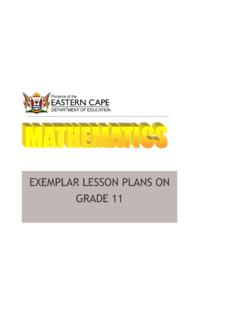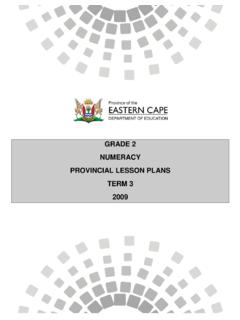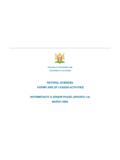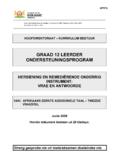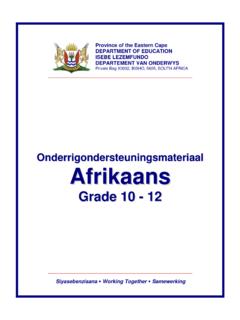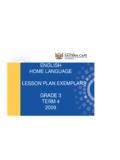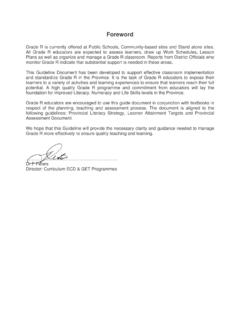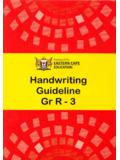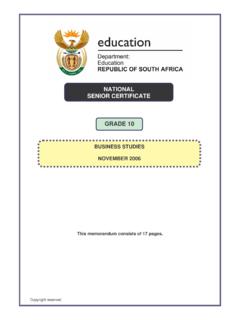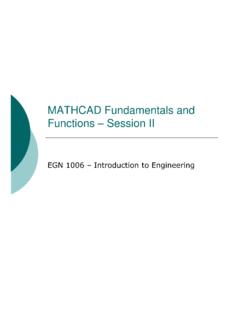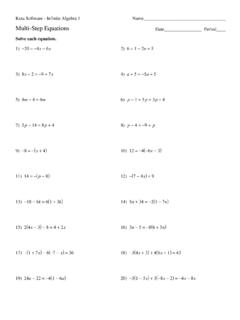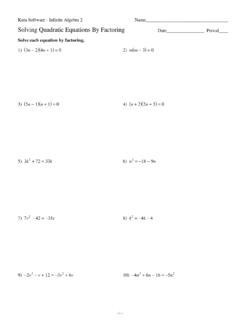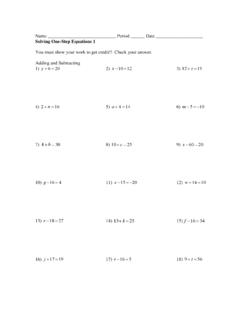Transcription of PROVINCE OF THE EASTERN CAPE EDUCATION
1 PROVINCE OF THE EASTERN CAPE EDUCATION DIRECTORATE: CURRICULUM FET PROGRAMMES LESSON PLANS TERM 3 MATHEMATICS GRADE 11 FOREWORD The following Grade 10, 11 and 12 Lesson Plans were developed by Subject Advisors during May 2009. Teachers are requested to look at them, modify them where necessary to suit their contexts and resources. It must be remembered that Lesson Plans are working documents, and any comments to improve the lesson plans in this document will be appreciated. Teachers are urged to use this document with the following departmental policy documents: Subject Statement; LPG 2008; SAG 2008; Examination Guidelines 2009 and Provincial CASS Policy / Guidelines. Lesson planning is the duty of each and every individual teacher but it helps when teachers sometimes plan together as a group. This interaction not only helps teachers to understand how to apply the Learning Outcomes (LOs) and Assessment Standards (ASs) but also builds up the confidence of the teachers in handling the content using new teaching strategies.
2 It must please be noted that in order to help teachers who teach across grades and subjects, an attempt has been made to standardise lesson plan templates and thus the new template might not resemble the templates used in each subject during the NCS training. However, all the essential elements of a lesson plan have been retained. This change has been made to assist teachers and lighten their administrative load. Please note that these lesson plans are to be used only as a guide to complete the requirements of the Curriculum Statements and the work schedules and teachers are encouraged to develop their own learner activities to supplement and /or substitute some of the activities given here (depending on the school environment, number and type of learners in your class, the resources available to your learners, etc). Do not forget to build in the tasks for the Programme of Assessment into your Lesson Plans.
3 Strengthen your efforts by supporting each other in clusters and share ideas. Good Luck with your endeavours to improve Teaching, Learning and Assessment. SUBJECT: MATHEMATICS GRADE 11 LESSON PLAN 1 TIME : 9 HOURS Context: Mathematical and building Link with previous lesson: Co-ordinate geometry ! " ! ! # $ $ # % & % '( ) ! ' % # % Learning Outcome 1: Number and Number Relationships When solving problems, the learner is able to recognise, describe, represent and work confidently with numbers and their relationships to estimate, calculate and check solutions. Learning Outcome 2: Functions and Algebra The learner is able to investigate, analyse, describe and represent a wide range of functions and solve related problems. Learning Outcome 3: Space, Shape and Measurement The learner is able to describe, represent, analyse and explain properties of shapes in 2-dimensional and 3-dimensional space with justification.
4 Learning Outcome 4: Data Handling and Probability The learner is able to collect, organise, analyse and interpret data to establish statistical and probability models to solve related problems. Understand that not all numbers are real. (a) Demonstrate the ability to work with various types of functions (b) Recognise relationships between variables in terms of numerical, graphical, verbal and symbolic representations and convert flexibly between these representations Use the formulae for surface area and volume of right pyramids, right cones, spheres and combinations of these geometric objects. Calculate and represent measures of central tendency and dispersion (a) Simplify expressions using the laws of exponents for rational exponents.(b) Add, subtract, multiply and divide simple surds (c) Demonstrate an understanding of error margins. Generate as many graphs as necessary, initially by means of point-by-point plotting, supported by available technology, to make and test conjectures about the effect of the parameters k, p, a and q for functions including Use a Cartesian co-ordinate system to derive and apply: * $ & % % & & $ + , # -& %.
5 & % , & * * & % & & Investigate number patterns (including but not limited to those where there is a constant second difference between consecutive terms in a number pattern, and the general term is therefore quadratic and hence: (a) make conjectures and generalisations b) provide explanations and justifications and attempt to prove conjectures. Identify characteristics as listed below and hence use applicable characteristics to sketch graphs of functions Investigate, generalise and apply the effect on the co-ordinates Use simple and compound decay formulae to solve problems (including straight line depreciation and depreciation on Manipulate algebraic expressions: (a) by completing the square; (b) Derive and use the values of the trigonometric functions / a reducing balance) (link to Learning Outcome 2). simplifying algebraic fractions with binomial denominators Demonstrate an understanding of different periods of compounding growth and decay Solve: a) quadratic equations (b) equations in two unknowns Solve problems in two dimensions Solve non-routine, unseen problems.
6 Use mathematical models to investigate problems that arise in real-life contexts: Investigate numerically the average gradient Solve linear programming problems TEACHING ACTIVITIES LEARNERS ACTIVITIES RESOURCES ASSESSMENT DATE COMPLETED Activity 1 :Rotation Teacher will find out from the learners their understanding of the word Rotation. The teacher will consolidate and come up with common understanding of rotation, using objects available to demonstrate the process. Teacher will issue out a worksheet informing learners what to do in groups. (See learner activity) Learners will come with different definitions of the word; some will even demonstrate their understanding. Learners will rotate an object until it reaches its original position, and will notice that a circle is formed. Learners will have to rotate a point until a circle is formed. Learners will have to draw a Cartesian plane with its origin Worksheet Text books Graph paper Mathematical instrument box Class works Home works Short tests Rubric, memo Educator, peer 0 Consolidation of direction (terminology and notation involved) and change of signs in coordinates.
7 Provide a worksheet where learners will rotate a terminal ray clockwise and anticlockwise through an angle of 900 and 1800. Teacher to consolidate and give more activities. Teaching Methods Question and answer Demonstration Investigation at the centre of the circle. Some learners rotating the point to the right others to the left observing the change of coordinates from one quadrant to the next one. Learners will work out the work sheet and they have to come up with conclusions regarding the two different angles. Activity 2 Enlargement Teacher will provide a worksheet where different polygons are represented on a Cartesian Learners are to work on worksheet to observe enlargement of the figures and record the conclusions. Worksheet Text books Graph paper Mathematical instrument box Class works Home works Short tests Rubric, memo 1 plane. Given a scale factor ask learners to enlarge the polygons. Teacher to consolidate the observation in the context of mathematics.
8 Teaching Methods Question and answer Demonstration Investigation Educator, peer Homework: Exercises given from selected textbooks and various resource material Enrichment/Expanded Opportunities: Additional question papers given Teacher Reflections: SIGNATURES: _____ _____ _____ _____ TEACHER DATE HOD / SMT DATE 2 SUBJECT: MATHEMATICS GRADE 11 LESSON PLAN 2 TIME : 9 HOURS Context: Finance, health, mathematical Link with previous lesson: Completing the square, grade 10 functions 3 $ & % ! " ! ! " $ # , # % # '( ) ! ' % Learning Outcome 1: Number and Number Relationships When solving problems, the learner is able to recognise, describe, represent and work confidently with numbers and their relationships to estimate, calculate and check solutions.
9 Learning Outcome 2: Functions and Algebra The learner is able to investigate, analyse, describe and represent a wide range of functions and solve related problems. Learning Outcome 3: Space, Shape and Measurement The learner is able to describe, represent, analyse and explain properties of shapes in 2-dimensional and 3-dimensional space with justification. Learning Outcome 4: Data Handling and Probability The learner is able to collect, organise, analyse and interpret data to establish statistical and probability models to solve related problems. Understand that not all numbers are real. (a) Demonstrate the ability to work with various types of functions (b) Recognise relationships between variables in terms of numerical, graphical, verbal and symbolic representations and convert flexibly between these representations Use the formulae for surface area and volume of right pyramids, right cones, spheres and combinations of these geometric objects.
10 Calculate and represent measures of central tendency and dispersion (a) Simplify expressions using the laws of exponents for rational exponents.(b) Add, subtract, multiply and divide simple surds (c) Demonstrate an understanding of error margins. Generate as many graphs as necessary, initially by means of point-by-point plotting, supported by available technology, to make and test conjectures about the effect of the parameters k, p, a and q for functions including Use a Cartesian co-ordinate system to derive and apply: * $ & % % & & $ + , # -& % . & % , & * * & % & & Investigate number patterns (including but not limited to those where there is a constant second difference between consecutive terms in a number pattern, and the general term is therefore quadratic and hence: (a) make conjectures and generalisations b) provide explanations and justifications and attempt to prove conjectures.
